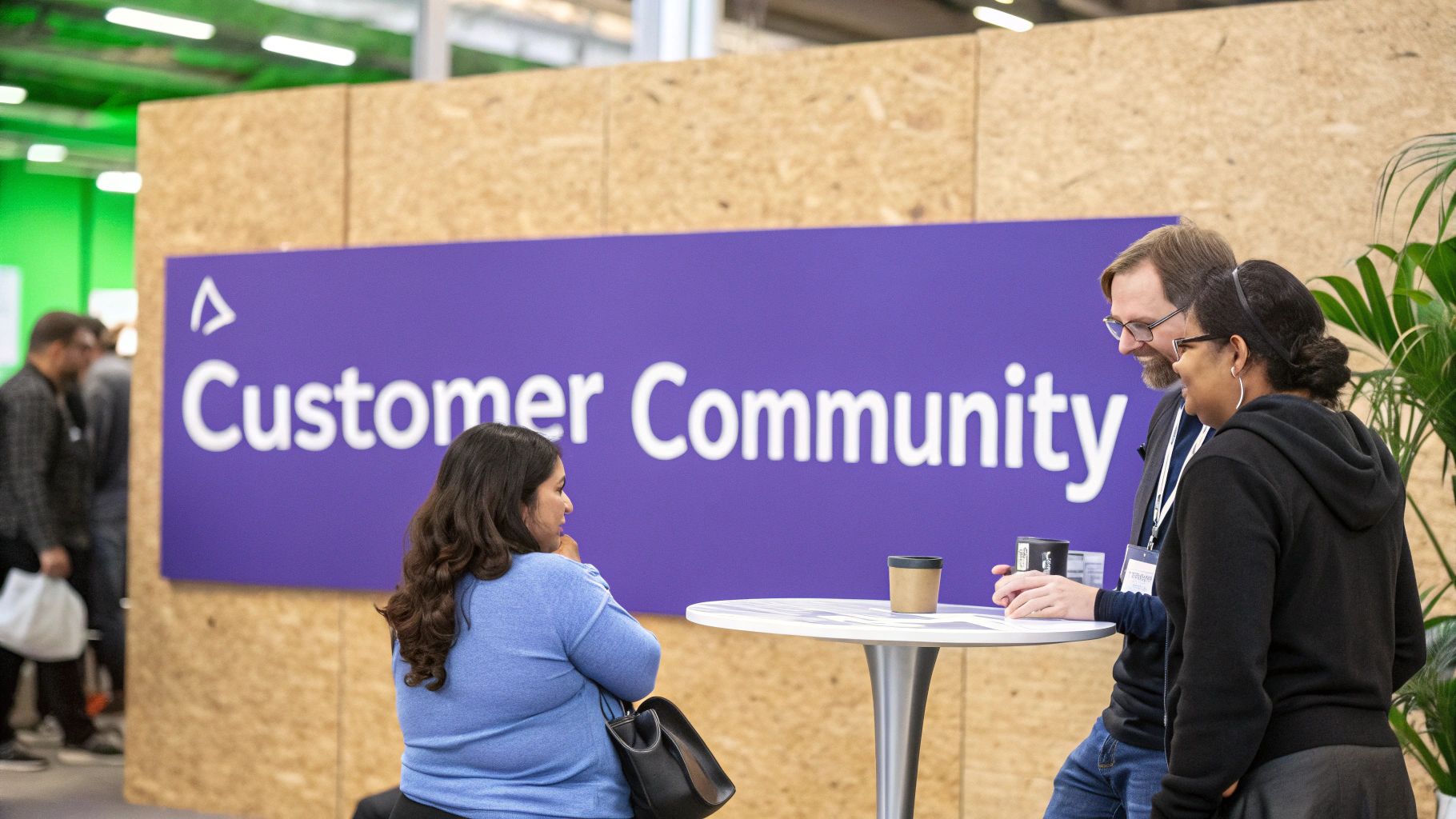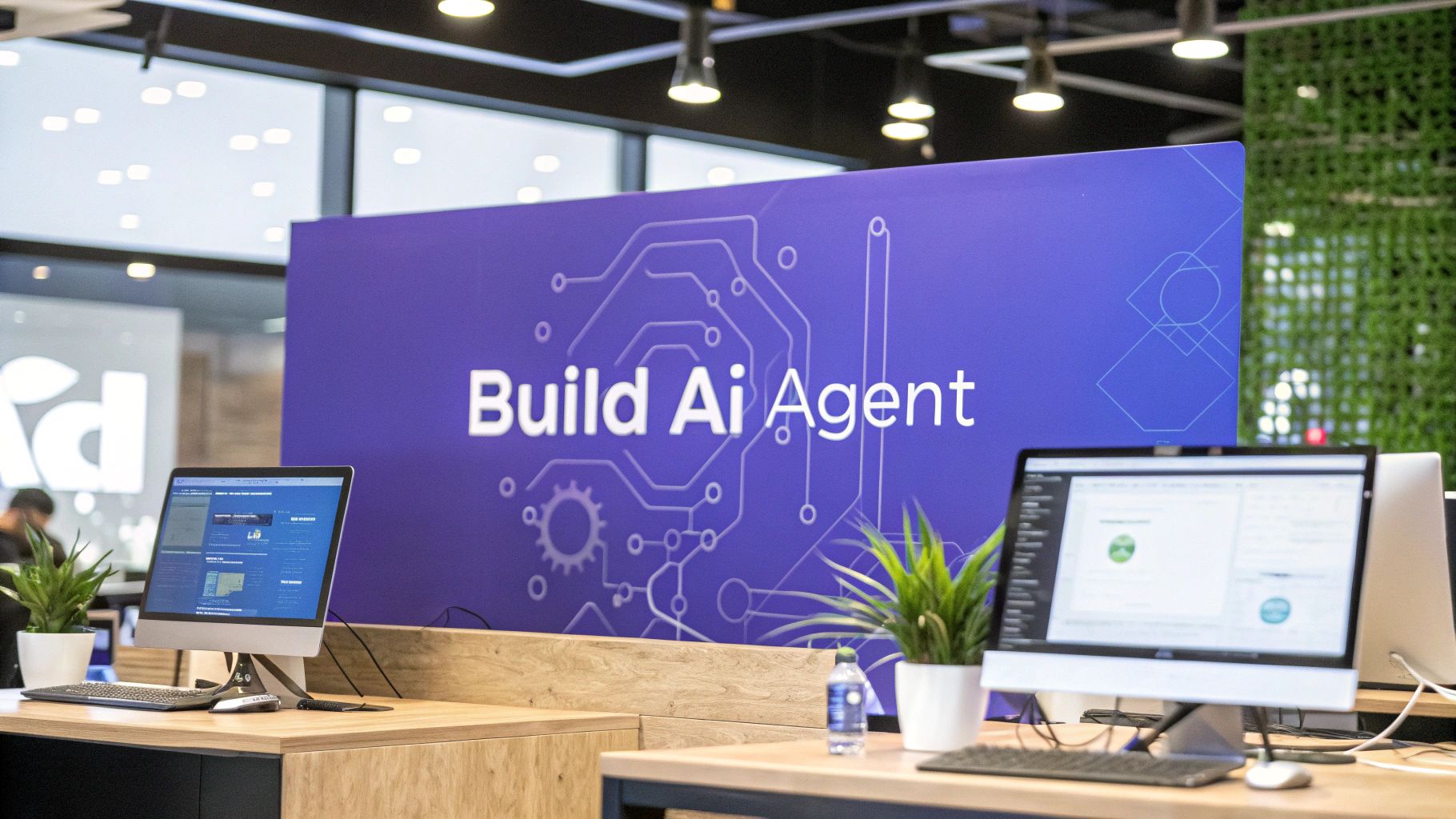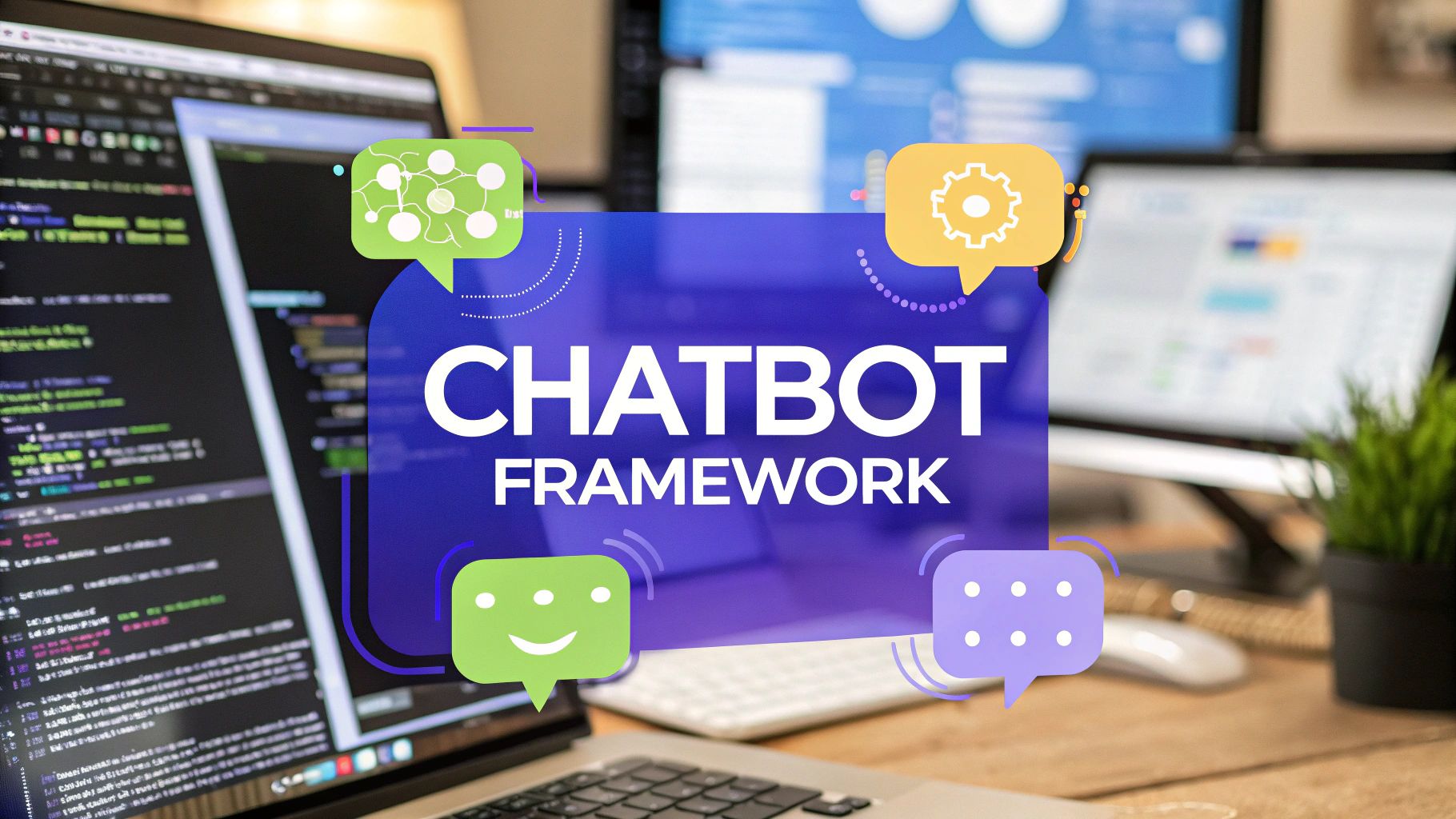Customer Success Strategies: Boost Retention & Growth
Discover customer success strategies to reduce churn and boost retention. Get practical steps and real-world examples to implement now.

Are you looking for better ways to keep your customers happy and engaged? It's a common challenge. Many companies rely on the same old methods, but retaining customers today requires a more advanced approach. Moving beyond basic support to a thoughtful, proactive model is a key part of business growth.
A strong customer success plan does more than solve problems. It actively helps customers get the most value from your product, which directly contributes to your own business success. When customers achieve their goals using your service, they are more likely to stay, expand their usage, and advocate for your brand. This guide breaks down 10 specific customer success strategies that deliver real results.
For each strategy, we will explore its core purpose and provide clear, actionable steps for implementation. You'll also learn how modern tools, specifically AI chatbots from Chatiant, can automate and improve these efforts, making your team more efficient and effective. We will cover everything from calculating customer health scores to building powerful advocacy programs. This article provides the blueprint you need to build a customer success function that drives retention and creates lasting customer relationships. Let's get started.
1. Customer Health Scoring
Customer Health Scoring is a system for evaluating the well-being of your customer accounts. It works by assigning a numerical score based on specific metrics like product usage, engagement frequency, and satisfaction levels. This data-driven method helps Customer Success teams proactively identify at-risk customers before they churn and spot upsell opportunities with satisfied clients. It moves teams from a reactive to a proactive stance and is a foundation of many effective customer success strategies.

Pioneered by platforms like Gainsight, this strategy is now a standard practice for SaaS companies looking to manage their customer relationships at scale. For instance, a software company might score a customer as "healthy" if they log in daily, use key features, and have submitted positive support tickets. An account with declining usage and an overdue invoice would receive a low score, flagging it for immediate intervention.
How to Implement Customer Health Scoring
To get started, focus on creating a simple yet effective model.
- Define Key Metrics: Start with 3-5 important indicators of health. These could include product adoption rate, support ticket volume, and Net Promoter Score (NPS). For a look into relevant data points, explore these essential client success metrics.
- Assign Weights: Not all metrics are equal. Decide which factors most accurately predict churn or expansion for your business and assign weights accordingly. For example, daily product usage might be more important than the number of support tickets opened.
- Review and Adjust: A health score is not static. Review your scoring model quarterly, comparing its predictions against actual churn and renewal data to refine its accuracy over time.
AI Enhancement with Chatiant: A Chatiant AI chatbot can automatically collect qualitative feedback through post-interaction surveys. This data can be fed directly into your health scoring model, adding a layer of customer sentiment to your quantitative usage data for a more complete picture.
2. Proactive Outreach & Engagement Programs
Proactive Outreach & Engagement Programs involve systematically initiating value-driven communication with customers at key moments in their journey. This strategy moves beyond reactive support. Teams can deliver relevant insights, best practices, and resources before customers even realize they need them. By anticipating needs based on lifecycle stage or usage patterns, you can guide users toward success, boosting retention and satisfaction. It's a key part of modern customer success strategies that builds loyalty.
Companies like Intercom and Appcues have popularized this approach by providing tools that trigger communications based on user behavior. For example, an e-learning platform might send a user a helpful guide on creating quizzes right after they use that feature for the first time. Similarly, Slack sends a series of onboarding emails and in-app tutorials to help new teams discover its most valuable collaboration features, creating a smooth adoption process from day one.
How to Implement Proactive Outreach & Engagement Programs
Building an effective program requires a thoughtful, customer-centric approach.
- Map the Customer Lifecycle: Identify key stages from onboarding to renewal and map out specific communication touchpoints for each. A new user needs different information than a seasoned power user.
- Use Behavioral Triggers: Set up automated messages based on user actions, such as adopting a key feature, reaching a usage milestone, or periods of inactivity. This makes your outreach timely and highly relevant.
- Balance Your Messaging: Create a mix of educational, supportive, and promotional content. Focus on providing value first to build trust, making your communications a welcome interaction.
AI Enhancement with Chatiant: A Chatiant AI chatbot can serve as a 24/7 proactive engagement tool. It can be configured to pop up with helpful tips based on what a user is doing in your app, offer guides when they navigate to a complex feature, or collect feedback after they complete a key task, scaling your proactive outreach effortlessly.
3. Onboarding & Implementation Excellence
Onboarding & Implementation Excellence is the structured process of guiding new customers to their first moment of value as quickly as possible. This first phase involves guided setup, training, and enablement to help users adopt the product effectively. A strong onboarding experience is foundational to long-term customer success. It significantly reduces early-stage churn and sets the stage for future loyalty and expansion. It turns a new sale into an active, successful partnership.
This strategy, championed by platforms like Appcues and Pendo, is a core component of modern customer success strategies. For example, HubSpot offers a comprehensive onboarding academy with certifications, while Stripe provides extensive developer documentation to make implementation seamless. These approaches help customers start using the product and achieve their desired outcomes from day one, which is important for retention.
How to Implement Onboarding & Implementation Excellence
To build a world-class onboarding process, focus on creating a clear, supportive, and value-driven journey.
- Define Success Milestones: Establish clear goals for the first 30, 60, and 90 days. What key actions must a customer take to see value? Celebrate these "quick wins" with them to build momentum. For a deeper look, review these customer onboarding best practices.
- Create Role-Based Paths: Customize the onboarding experience for different user types, such as administrators, end-users, and executives. Each role has unique needs and goals, and a specific path accelerates their time-to-value.
- Provide Diverse Learning Formats: Offer a mix of learning materials to accommodate different preferences. Combine interactive product tours, in-app guidance, video tutorials, and live training sessions to create a complete and engaging program.
AI Enhancement with Chatiant: A Chatiant AI chatbot can serve as a 24/7 onboarding assistant, guiding new users through setup tasks, answering common questions, and providing contextual help within your application. This automates routine guidance, allowing your team to focus on more complex implementation challenges.
4. Regular Business Reviews (QBRs)
Regular Business Reviews, often called QBRs, are strategic meetings held between your team and your customer's leadership. These sessions go beyond simple check-ins. They are a formal opportunity to demonstrate the value your product delivers, align on future goals, and strengthen the partnership. By reviewing performance metrics and discussing strategic initiatives, QBRs provide accountability and uncover expansion opportunities at an executive level, making them one of the most impactful customer success strategies.
This practice was popularized by enterprise SaaS giants like Salesforce and Workday to manage high-value accounts. For example, a Salesforce account executive will meet with a client's VP of Sales to review how the CRM has impacted sales cycle length and team productivity over the last quarter. This data-driven conversation solidifies the ROI and sets the stage for discussing new features or services that align with the client’s upcoming business objectives.
How to Implement Regular Business Reviews
Effective QBRs require preparation and a focus on the customer's perspective.
- Set a Strategic Agenda: Before the meeting, send a pre-QBR questionnaire to get a sense of the customer’s priorities. Build the agenda around their business outcomes, not just your product features.
- Prepare a Data-Driven Narrative: Come prepared with a complete dashboard showing KPIs and progress toward their goals. Visualize the value they have received and use data to support your recommendations for the next quarter.
- Document and Follow Up: The meeting's value diminishes without clear next steps. Conclude by documenting action items, assigning owners, and setting deadlines. Follow up between meetings to check on progress.
AI Enhancement with Chatiant: Use a Chatiant AI chatbot on your customer portal to collect ongoing feedback and priorities from key stakeholders. This information can be automatically summarized and provided to the Customer Success Manager before a QBR, helping them walk into the meeting with a full picture of the customer's current sentiment and top concerns.
5. Customer Advisory Boards (CABs)
Customer Advisory Boards (CABs) are structured programs that bring together key customers to provide strategic advice. These select groups offer direct feedback on product roadmaps, market trends, and overall company direction. This strategy turns the vendor-customer dynamic into a true partnership. It provides valuable insights while strengthening relationships with your most important accounts. It is one of the most powerful customer success strategies for building long-term loyalty and co-creating value.
This approach has been popularized by major enterprise companies like Salesforce and Adobe, which run executive councils to guide their product evolution. For example, HubSpot’s CMS Advisory Board helps steer the future of its content management system by gathering feedback from top users. The insights gained from a CAB are direct, relevant, and help make sure your strategic decisions align perfectly with the needs of your target market.
How to Implement a Customer Advisory Board
Building an effective CAB requires careful planning and a commitment to action.
- Select Diverse Members: Invite a representative mix of customers from different segments, industries, and use cases. This provides a well-rounded perspective instead of feedback from a single user profile.
- Establish a Clear Charter: Define the CAB's purpose, goals, and member expectations from the start. Outline the time commitment, meeting frequency, and what topics will be discussed so members know their role.
- Track Feedback to Action: Create a formal process for documenting all feedback and assigning action items. It is important to publish transparent updates showing members exactly how their input influenced product decisions, closing the feedback loop.
AI Enhancement with Chatiant: A Chatiant AI chatbot can serve as a "digital concierge" for your CAB members. It can handle scheduling, send meeting reminders, and collect pre-meeting feedback on specific agenda items. Post-meeting, it can distribute surveys to gauge the effectiveness of the session, making the entire process more efficient.
6. Data-Driven Decision Making & Analytics
Data-driven decision making is the practice of using objective evidence from customer data and analytics to inform customer success initiatives. This approach moves teams away from relying on intuition. It grounds their actions in measurable insights about product usage, customer behavior, and business metrics. It is one of the most powerful customer success strategies for prioritizing efforts where they will have the most impact.

Popularized by platforms like Amplitude and Pendo, this strategy enables teams to predict outcomes and prove their value. For example, a CS team might use cohort analysis to discover that customers who adopt a specific feature within their first 30 days have a 40% higher retention rate. Armed with this data, they can focus their onboarding efforts on driving adoption of that key feature, knowing it directly correlates with long-term success.
How to Implement Data-Driven Decision Making
Getting started means focusing on accessible, high-impact data points first.
- Establish Key Metrics: Begin by defining 5-10 metrics that truly reflect customer value and engagement. These could include adoption rates for key features, session duration, or the frequency of specific actions within your product.
- Create Dashboards: Build and automate dashboards using BI tools to provide your team with real-time visibility into these metrics. This makes sure everyone is working from the same source of truth.
- Combine Data Types: Mix quantitative data (like usage stats) with qualitative feedback (like survey responses or support ticket themes). This combination provides a complete story behind the numbers, explaining why customers behave the way they do.
AI Enhancement with Chatiant: A Chatiant AI chatbot can analyze support conversations in real time to identify emerging trends and customer pain points. This insight can be automatically logged and categorized, giving your team immediate, data-backed visibility into issues that might otherwise go unnoticed until they appear in churn metrics.
7. Segmentation & Tiered CS Model
A Segmentation and Tiered Customer Success (CS) Model is a strategic framework that categorizes customers into distinct groups. These segments are typically based on criteria like company size, revenue, or strategic value. This approach allows you to provide different levels of service and engagement, optimizing resource allocation by balancing high-touch management for top accounts with efficient, tech-driven support for others. It helps every customer receive the appropriate level of attention.
This model is a standard practice in the SaaS industry. For instance, HubSpot offers different support and success resources for its free, professional, and enterprise tiers. Similarly, Salesforce structures its customer management in a pyramid, with dedicated, high-touch teams for enterprise clients and more scalable solutions for its SMB and mid-market segments. This method helps manage a diverse customer base effectively, which is a common challenge for growing companies.
How to Implement a Tiered CS Model
Begin by creating clear and logical segments for your customer base.
- Define Segment Criteria: Clearly outline what separates one tier from another. This could be monthly recurring revenue (MRR), growth potential, or product complexity. Understanding various customer segmentation strategies is a key first step.
- Establish Service Levels: Document the specific resources, response times (SLAs), and success activities allocated to each tier. For example, your top tier might get a dedicated CSM, while lower tiers rely on a pooled CSM model and digital resources.
- Automate for Lower Tiers: Use automation and self-service tools heavily for lower-value segments. This provides them with the support they need to succeed without straining your high-touch resources.
AI Enhancement with Chatiant: A Chatiant AI chatbot can serve as the primary support and onboarding channel for your lower-tier customers. It can answer common questions, guide users through features, and collect feedback 24/7, providing a scalable yet personalized experience that helps prevent churn in these segments.
8. Community Building & Customer Advocacy
Community Building and Customer Advocacy is a strategy centered on creating spaces where customers can connect, share knowledge, and support one another. This builds a sense of belonging and turns satisfied customers into active brand advocates. A strong community becomes a self-sustaining ecosystem that reduces the burden on support teams, provides valuable product feedback, and generates powerful word-of-mouth marketing. It's one of the most scalable customer success strategies for long-term growth.

Pioneered by companies like Salesforce with its massive Dreamforce conference and Trailblazer community, this approach is now a staple for brands aiming to build strong customer relationships. For example, HubSpot's INBOUND conference and online forums allow users to learn from experts and peers, solidifying their investment in the HubSpot platform. Similarly, Slack's customer community is a vibrant hub for users to share tips and build custom integrations, directly increasing product stickiness.
How to Implement Community Building & Customer Advocacy
You can start small and build momentum over time.
- Launch a Digital Hub: Begin with a simple online forum, a dedicated Slack channel, or a private social media group. Focus on a platform where your customers are already active to lower the barrier to entry.
- Recognize Champions: Identify your most active and knowledgeable users. Recognize them as community champions or moderators, giving them a special status and helping them to help others.
- Create Structured Programs: Develop formal programs to channel advocacy. This could be an ambassador program for influencers, a referral program for all customers, or a partner program for agencies and consultants.
- Recognize and Reward: Acknowledge contributions publicly. Offer rewards like exclusive content, early access to new features, or company swag to incentivize participation and make members feel valued.
AI Enhancement with Chatiant: A Chatiant AI chatbot can act as a community concierge, answering common questions and directing users to relevant discussions or knowledge base articles. It can also monitor community sentiment by analyzing conversations for keywords, helping your team proactively address issues and identify brand advocates.
9. Outcome-Based Customer Success Planning
Outcome-Based Customer Success Planning is a strategy that shifts the focus from your product's features to the business results a customer wants to achieve. Instead of just making sure they use the software, Customer Success teams work directly with clients to define, document, and track specific business outcomes. This approach aligns all success activities with helping the customer achieve their primary strategic goals.
This method transforms the customer relationship into a strategic partnership. For example, a company like Salesforce doesn't just sell CRM software; its success teams help clients achieve specific outcomes like "increase sales pipeline by 20%" or "reduce customer service response times by 30%." Similarly, a Workday implementation is centered on achieving HR transformation outcomes, not just deploying a system. This makes your product indispensable to their business success.
How to Implement Outcome-Based Customer Success Planning
Begin by integrating this outcome-focused mindset into your customer onboarding and review processes.
- Define Primary Outcomes: During discovery calls, work with the customer to identify and agree on 2-3 primary, measurable business outcomes they want to achieve. Avoid getting distracted by too many competing goals.
- Establish Baselines and Milestones: Before full implementation, establish baseline metrics to measure progress against. Create a roadmap with clear milestones to track the journey toward the desired outcome and celebrate small wins along the way.
- Create an Outcome Review Cadence: Schedule regular (monthly or quarterly) business reviews dedicated to discussing progress toward the defined outcomes. Use these meetings to adjust strategy and demonstrate value, which serves as a natural foundation for renewal and expansion conversations.
AI Enhancement with Chatiant: You can deploy a Chatiant AI chatbot to proactively check in with key customer stakeholders, asking targeted questions about their progress toward defined outcomes. The bot can then summarize this feedback and flag any deviations from the plan, allowing your CS team to intervene with the right support at the right time.
10. Voice of Customer Programs (VoC)
Voice of Customer (VoC) programs are a systematic way to gather, analyze, and act on customer feedback from multiple sources. Instead of waiting for customers to report problems, this strategy actively seeks out their opinions to inform everything from product development to the core customer success approach. It establishes a structured feedback loop, helping the customer's perspective become a primary driver of company decisions.
This approach is central to how major companies operate. For instance, Adobe's VoC program directly influences the Creative Cloud roadmap, while Salesforce uses structured feedback loops to prioritize updates across its product lines. A successful VoC program turns customer sentiment into actionable data, making it one of the most impactful customer success strategies.
How to Implement a Voice of Customer Program
A successful program relies on a consistent process for collection and action.
- Establish Collection Channels: Create a structured feedback process using multiple methods. This can include NPS and CSAT surveys to identify trends, quarterly business reviews, and ongoing customer interviews for deeper insights.
- Analyze and Theme Feedback: Don't just track individual comments. Group feedback into themes and patterns to identify the most significant opportunities and pain points. For a deeper look at this process, review these techniques for analyzing customer feedback.
- Close the Loop: Share findings across the organization, from product to marketing. Most importantly, communicate back to customers how their feedback led to specific changes, which builds trust and encourages future participation.
AI Enhancement with Chatiant: A Chatiant AI chatbot can act as a 24/7 feedback collection channel. It can be programmed to ask targeted questions during support interactions or on key website pages, capturing in-the-moment sentiment and automatically tagging it for easier analysis.
10-Point Comparison of Customer Success Strategies
Putting These Strategies Into Action
Building a world-class customer success program is a marathon, not a sprint. We have explored ten powerful customer success strategies, from establishing a data-backed Customer Health Score to orchestrating a complete Voice of the Customer program. Each strategy represents a significant opportunity to move from a reactive support model to a proactive, value-driven partnership with your clients. The common thread connecting all these approaches is a strong commitment to delivering on your customer's desired outcomes.
The key takeaway is that you don't need to implement everything at once. Attempting to launch all ten strategies simultaneously would stretch your team thin and likely lead to poor execution. Instead, the most effective approach is incremental and fitted to your unique business needs. Start by identifying the most significant point of friction in your current customer journey. Is it a confusing onboarding process? A lack of engagement post-sale? High churn rates among a specific customer segment? Pinpointing this primary challenge will help you select the one or two strategies that will deliver the most immediate impact.
Your First Steps to Success
Your initial focus should be on building a solid foundation. Here’s a practical path forward:
- Start with Data: Begin with a strategy like Data-Driven Decision Making or a basic Customer Health Score. You cannot improve what you do not measure. Gaining clarity on customer behavior and sentiment provides the necessary context for every other initiative.
- Prioritize Onboarding: A flawless Onboarding & Implementation experience sets the tone for the entire customer relationship. If this is a weak point, making it your top priority can drastically reduce early-stage churn and improve long-term adoption.
- Listen Actively: Implement a simple version of a Voice of the Customer program. This could be as straightforward as sending a post-onboarding survey or using an AI-powered chatbot to collect feedback after support interactions.
Ultimately, the effectiveness of these customer success strategies is measured by their impact on reducing churn and boosting retention. For a deeper look into practical approaches, explore comprehensive strategies to reduce churn rate and boost retention. Mastering these concepts is not just about keeping customers happy. It's about turning them into loyal advocates who actively contribute to your company's growth. By starting small, measuring your results, and consistently iterating, you will build a customer success engine that becomes a powerful competitive advantage.
Ready to automate and scale your customer success efforts? Chatiant provides AI-powered chatbots designed to support your key strategies, from seamless onboarding and proactive engagement to instant feedback collection. Discover how you can free up your team to build stronger relationships by visiting Chatiant today.


